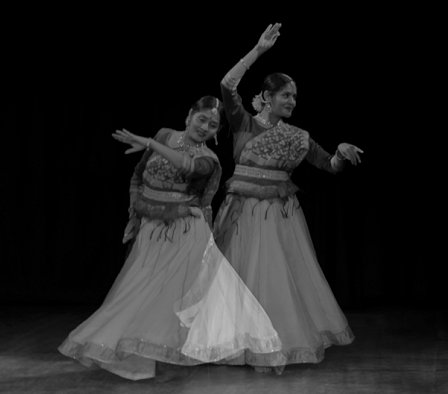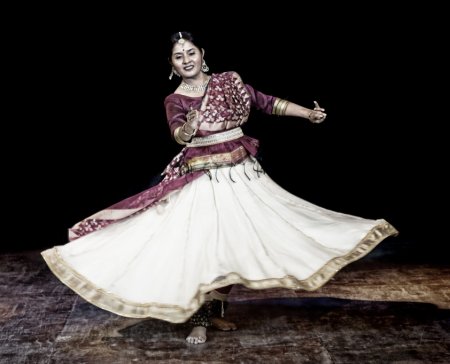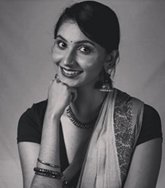
|   |

|   |
Umang: An evening of swirls, stories and satisfaction - Shreyaa Suresh e-mail: shreyaa.suresh1712@gmail.com Photos: Santoshkumar Janardanan September 27, 2022 On the 27th of August, managing a hectic Saturday evening traffic, I made it to the Alliance Francaise of Madras to witness 'Umang' performed by Swati Potulwar and the students of Kathak Abhijaat - a Kathak institute run by Swati Potulwar in Chennai since 2017. Swati Potulwar is a disciple of Guru Prerana Deshpande from Pune. Every art form comes into being through culture and also inspires different cultures through its presence and performance. Among the umpteen number of sabhas in and around the city, the cozy space of Alliance Francaise renders itself perfectly for the craft of story-telling through Kathak. The distance between the stage and the audience that sabhas provide, divide the art as an elevated, mystic surreal form, unreachable by the masses. Kathak draws you in, quite literally with the slender movements of the hands, and takes you, the audience, with the dancer as well as the musicians on an enthralling ride. There is no physical or metaphoric separation between the artistes on stage and the audience, and is accessible to all that hop on this ride.  Perhaps the most impressive thing about learning the art of Kathak is how it not only tests your physical ability to perform and showcase the tatkar (footwork) and the paran (a structural composition set to a rhythmic pattern based on the taal) in the fastest of speeds but also your cognitive ability in grasping the mathematical pattern itself that is danced (ginthi). Through reciting the paran first and then performing it, it develops a practice to bring together the mind and body. From the tiny tots to the older students, this riyaaz was evidently seen and is required to nurture the body to bring together the silent gaps and the loud beats and, in a sense, master space and time. In every piece that was performed, is a dual dialectic, a pull-push of simple and complex movements. It is in this manipulation, between the elegance of the torso and body and force of the feet, where the attractiveness of the art lies. From the Vishnu Vandana that began the recital, smoothly inviting the audience into the journey of the show, it quickly took pace with the teen taal where rhythmic beats contrasted with the initial start of graceful movements. Alternating back to the Sargam with musical interludes brought the melody while yet again picking up pace with the drut teen taal that included sharp chakkars (turns) and calculative bandishs (mathematical set of movements) kept the contrast. This contrast, I feel, is key to creating enjoyment in the audience, for who would like a rollercoaster if it only went one way? I would say the purpose of art is the derived enjoyment from involving yourself in its journey. It is about building that connection between the various performers, when the harmonium artiste could not help but appreciate the intricate gamakas sung by the singer, and when Swati’s recitation, the tabla’s beat and Kalyani Gokhale’s control of the taal came together. It is in these moments of connection that the art is touching the souls of every being in that space.  Swati Potulwar There is no language that is required. Everything is understood through the body, and most importantly directed by the eyes. The calm Swati is soft spoken even during the rehearsals. If there is a mistake, it is corrected through the language of her eyes. While soft spoken in her words, one cannot miss Swati’s sharp and striking looks that feature through her performance from the powerful Shiv Vandana, to the thaat that includes various body and neck movements. What I enjoyed most about her solo recital, both in the rehearsals and on stage was how your body can tell a story. In comparison to Bharatanatyam that has mudras or hand gestures for every word of the lyrics, known as padartha abhinayam, Kathak simplifies this process. Without spelling out every word through a cryptic hand gesture, Kathak finds its solace in telling every story in the most relatable way. I particularly enjoyed the Thumari performed by Swati in her solo. The iconography of Krishna in Bhakti literature, explained through the everyday actions of fetching water or preparing the curds, brings together the mystic and the realistic in the most palpable way. The freedom from mudras (hand gestures) allows for a subjective takeaway for the audience, where the presentation of Krishna, while remaining relatable, allows for different imaginations within each of the audience member. The greatest ability of art is to allow for these diverse narratives. And I believe it is truly a high achievement of the performer, through their own creativity, to have an effect on the imaginations and perceptions of the audience. It is not just in the abhinaya that there is a connection; even though mathematical, the rhythmic beats, bols and sounds are inspired from nature, the instruments and everything around us. This archaic form of storytelling, inspired from the world around, has an important purpose. The purpose of tying that began with the gunghroos as the foremost practice of every Kathak dancer, expanded to the performance that ties together different stories and people, finally coming to a conclusion on that beautiful night with a Tarana by Swati, that combined the contrasts of the laya and taal, all into one piece.  Shreyaa Suresh is a Theatre and Bharatanatyam teacher and extremely passionate about Art. She is an aspiring academic and hopes to pursue a doctorate in Anthropology specializing in Art and Culture. |